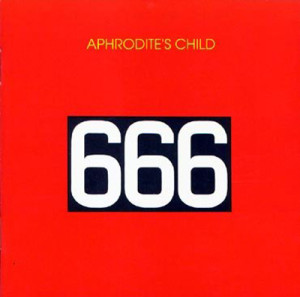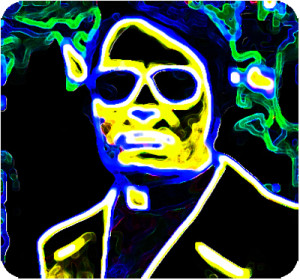 2012 marks the 40th anniversary of the release of “666,” the third and final album of the Greek progressive rock band, Aphrodite’s Child. “666” haunted my teenage years in the late seventies and my ensuing voyage through sex, drugs and strong drink while I was a professional waiter and seminary student. It is a concept record that is of its time and yet utterly timeless. A carnival troupe of musicians and performers are mounting an extravaganza based on the Book of Revelation when the actual Apocalypse begins outside the bigtop. The two shows merge and climax, as it were. The album contains within its spirit a very piquant critique of the 1960’s and the ultimate failure of radical youth movements to avoid their own decadence and to transcend the decadence of their gurus and leaders.
2012 marks the 40th anniversary of the release of “666,” the third and final album of the Greek progressive rock band, Aphrodite’s Child. “666” haunted my teenage years in the late seventies and my ensuing voyage through sex, drugs and strong drink while I was a professional waiter and seminary student. It is a concept record that is of its time and yet utterly timeless. A carnival troupe of musicians and performers are mounting an extravaganza based on the Book of Revelation when the actual Apocalypse begins outside the bigtop. The two shows merge and climax, as it were. The album contains within its spirit a very piquant critique of the 1960’s and the ultimate failure of radical youth movements to avoid their own decadence and to transcend the decadence of their gurus and leaders.
As a Christian existentialist and liberation theologist, I find “666” to be, as Claude Levi-Strauss suggested, “good to think with.” Mostly instrumental, the record pounds and smashes with remorseless energy, throwing off vibrations and perfumes of spiritual disquiet and primal desire. It rubs your nose in the fury of existence and spooks you to the marrow. It is an “inconvenient” Christian text, at once ancient and modern, rife with the distressing absence of a recently-departed Christ. Concurrently, the record is militantly amillennial in the tradition of the Greek Orthodox church. You must keep making your witness, it implies, because only God knows when the Second Coming is en route. Beware false prophets, preachers and politicians telling you otherwise.
When I think of false prophets, the Apocalypse and the 1960’s, Jim Jones first comes to mind. Apocalyptic thinking is defeatist thinking – the world is going to end so why bother trying to change the world. Lord, we’re fallen, we’re tired. That’s just the sort of rubbish Jim Jones used in his last sermon at Jonestown to convince his followers to give up on the noble mission that brought them to Guyana and succumb to the fever dream of death that had bewitched Jones since his troubled youth in rural Indiana.
For me, Jones is the most fascinating figure of 1960’s social justice movements precisely because his Peoples Temple was poised to be a viable, ongoing success in the bitter backwash of the previous decades’ failures. Peoples Temple in the mid-seventies was a powerful engine of community activism in San Francisco and Jones was the toast of the leftist intelligentsia, from Mayor Moscone all the way to First Lady Rosalind Carter. Peoples Temple at its best is hiding in plain sight of the grim, fetishized shadow cast by Peoples Temple at its worst.
The ideal of Peoples Temple remains inspiring. Post WWII America devolved into a madhouse of consumption, dislocation and aggressive loneliness. Millions were cut loose from family and friends. Safe harbors were few and far between. A so-called Christian nation lost touch with Jesus, the actual man of kindness and mercy. Jones offered searchers and ramblers a real opportunity to be part of something to which they could belong and contribute and find meaning in their lives through agape and caritas. The rainbow community of Peoples Temple, however briefly, provided a vital safety net for the misbegotten and a springboard for self-actualization.

Jones scuttled his ministry because he himself got lost. I was struck by how, despite all his revival tent razzle dazzle, Jones was spiritually ground down into a churlish atheist by the grim realities of human suffering, prejudice and stupidity he encountered in Indiana and Brazil. Perhaps already well-unhinged, he escaped into drugs, Cold War paranoia and pansexual trolling, rendering him both dangerously messianic and manifestly ill-suited for leadership of a very vulnerable yet productive flock. Jones had no business in Jonestown. In a parallel universe, Congressman Ryan should have been Captain Willard sent to dispatch Jones’ Colonel Kurtz.
The magnum opus of “666” is a 19 minute track called “All The Seats Were Occupied.” Over-run with voices and tribal percussion and exotic instrumentation, the song is a relentless nightmare hallucination of the 1960’s broken dream of revolutionizing a world of greed and waste, rigged to enrich few and destroy many. For me, the Jonestown Massacre, not the Hell’s Angels’ skullduggery at Altamont, is the true violent climax of that dream’s demise. Listening to this track as I think of the last day of Jonestown, my skin crawls. One last orgasm for Jones: the ecstasy of Death and the death of an epoch’s hope.
Different false prophets are with us now, some wired, some unplugged. And “666”’s imperative has never been more valuable. Or daunting.
(Lincoln Swain is the pseudonym of an Episcopal priest and theologian living in Metro Detroit. His work focuses on existential Christianity and social history. His previous works include Dare to Defy (Atomic Quill Press 2005) and Oh Wow (Atomic Quill Press 2012). This essay is excerpted from a longer work, “The Why People: Faith, False Prophets and End Times,” which is available through Amazon.)